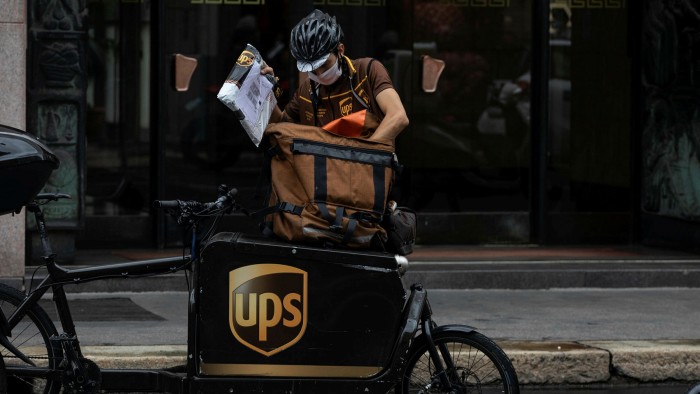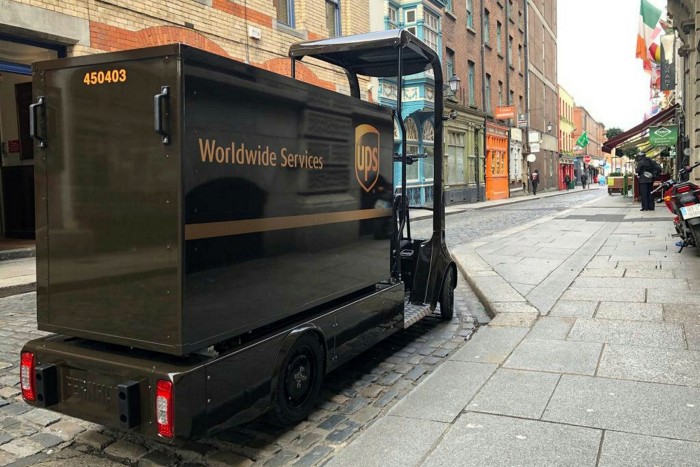Parcel groups seek to deliver greener ‘last mile’ processes

Roula Khalaf, Editor of the FT, selects her favourite stories in this weekly newsletter.
The streets and cycleways of the world’s cities will soon be filling up with robots, electric cycles and vans as logistics companies try to solve their toughest challenge — the “last mile”.
The final journey from warehouse to customer is a fraction of the journey a product makes from factory to door, but can account for up to half the cost.
Transferring a package to a delivery vehicle and getting it to a specific address is a difficult process to automate. And a surge in parcel deliveries has put companies under pressure from politicians to tackle two unwelcome consequences — congestion and pollution.
Parcel volumes have been rising around 10 per cent annually in developed markets and doubling ever year in countries such as India, according to a 2016 report by consultants McKinsey. The coronavirus pandemic, which has forced people to stay indoors and order online, has exacerbated the trend.
McKinsey’s 2016 prediction that within 10 years almost every consumer parcel — 80 per cent of total volumes — would be delivered by robots seems far fetched now. While there is still much excited talk about drones transforming consumer logistics, most experts believe that more down to earth and cost-effective solutions are at hand.
Thomas Zunder, principal research associate of the Future Mobility Group at the University of Newcastle in northern England, notes that there is not enough air space over London to deliver every package there by air.
He believes the future will look a lot like the past — people, vans and bicycles, yet with technological assistance.
Newcastle’s latest experiment is effectively a robot sherpa. A delivery person will walk the streets followed by three small robots containing the parcels to boost carrying capacity without using a vehicle.
“For delivering to a door it is very hard to replace a human being. So you give him support,” Prof Zunder says.
UPS, the American logistics giant which delivers 22m packages a day and has $74bn annual revenues, is working on similar ideas. Its latest designs include electric cycles and an electric cart that an individual can pull. Each can hold 200kg of parcels and use pavements and cycle paths, reducing the strain on roads.

Prof Zunder says such innovations are vital. Local authorities and national governments are starting to impose congestion or pollution charges on commercial vehicles with conventional fuels and taking out parking spaces to discourage urban traffic. Other cities have created freight corridors which force big trucks down certain highways to distribution centres on the outskirts.
Some have established consolidation centres. This forces all traffic to one giant warehouse with a single provider providing last-mile delivery, which in theory can be more efficient. In 2008, the landlord Crown Estate, which controls property owned by the UK monarch, found that congestion in Regent Street, one of central London’s most prestigious shopping streets, was deterring visitors. It found delivery vehicles accounted for 35 per cent of all peak-hour traffic in the retail district. So it obliged shops across the West End to use a single consolidation centre with one provider delivering from there. Similarly, the principality of Monaco forces all parcel carriers to use a single site, with just one company providing final delivery.
But couriers do not want others to be responsible for their customer data and products. “It is difficult to do in a liberalised economy,” says Prof Zunder. “They only work when the territory is controlled by a state or a landlord.”
He ran a consolidation centre at his university with Clipper, a delivery company. It reduced pollution but the university decided it did not want to pay the extra £100,000 a year of operating the system.
UPS says such centres only work where there is a dense network of customers but adds such solutions can become even greener. In 2012, it established a large warehouse in Hamburg city centre which is filled once a day and then serviced entirely with e-cycles.
Peter Harris, international sustainability director at UPS, said most carriers had made their networks more efficient with route-planning systems and alternative delivery points such as convenience stores, which meant shorter journeys and more first time deliveries. “But on its own, it won’t solve the problem,” he says.
Hence the electrification. Progress has been constrained by an overloaded power network in many countries and a lack of cheap, purpose-built electric vehicles. UPS has converted some diesel vans to battery power but that has proven expensive. It now has 10,000 of its 125,000-strong fleet worldwide electrified. Then it decided to invest in its own electric vehicle working with Arrival, a UK start-up.

The complete rethink led to a skateboard design with in-axle motors. The familiar UPS van shape, with its storage over the driver’s head, remains but it is sleeker and has a larger window. UPS is buying at least 10,000.
The power supply bottleneck soon became apparent at its London depot. “We got to 10 vehicles and we could not plug in another one because all the lights went out,” says Mr Russell. After paying for an upgraded power supply, UPS decided on a new approach. With government funding and collaboration with an electricity supplier it created a grid scale smart grid and energy storage system. That trebled the capacity for charging by tapping into times when the grid was less busy.
UPS has also ordered 125 of Tesla’s electric HGVs but in the US has opted for renewable gas as its fuel of choice.
FedEx, another US carrier, is also moving to electrify. But Roxo, the courier’s under-development delivery robot, is not yet welcome everywhere. It is being tested in US cities but when a demonstration unit went for a stroll in New York City in November, mayor Bill de Blasio banned it, worried about it blocking pedestrians and taking jobs from humans.
Mr Harris says that by 2025 40 per cent of UPS’s fleet would be powered by alternative fuel and costs were dropping all the time. “We are pushing fast towards the point where these technologies are not only sustainable solutions but commercial common sense. That is where we have got to get to.”
Comments